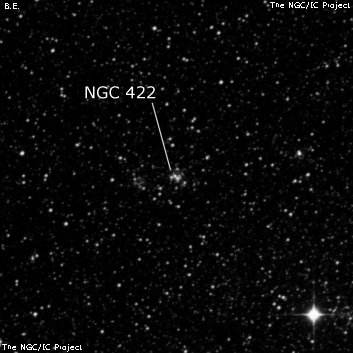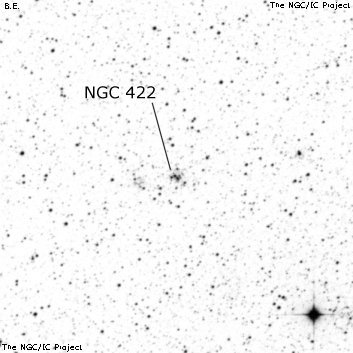NGC/IC Project Restoration Effort
(This is a very very beta version)
NGC422


Basic Information
Location and Magnitude
Right Ascension: 1:9:25.4
Declination: -71:46:0
Constellation: TUC
Visual Magnitude: 13.4
Historic Information
Discoverer: Herschel J.
Year of discovery: 1835
Discovery aperture: 18.3
Observational
Summary description: vF (in Nubec. minor)
Sub-type: OCL
Corwin's Notes
=====
NGC 422 is an accidental duplicate entry for NGC 411. There is nothing at the
place of this SMC object on the sky, and the faint cluster (IC 1641) 30+
seconds of time to the east is almost certainly too faint for JH to have
picked up.
This piqued my curiosity, and I found that NGC 422 comes from JH's table of
"Stars, Nebulae, and Clusters in the Nubecula Minor" where it is number 162.
(Dreyer has correctly copied the position and class -- "III" = vF nebula --
into the NGC.) In that table, JH also has a sweep symbol in the "Zone" column
indicating that the object comes from the sweeps with the 20-foot reflector
rather than from his zone sweeps with a five-inch achromatic refractor
(IC 1641 is certainly too faint to have been seen in the five-inch). However,
no such object exists in JH's big table of "Reduced Observations of Nebulae
and Clusters of Stars".
There is, however, an entry in the "Reduced Observations ..." table, for NGC
411 (= h 2384) at just one minute of time preceding the position for NGC 422.
Furthermore, it has two positions given, the first of which has become number
157 in the Nubecula Minor table, while the second position is, as we've seen,
that for number 162 in the same table but with the RA increased by exactly one
minute of time; the north polar distance is correctly copied. It's clear,
then, that the object was accidentally duplicated in the SMC table, and
therefore eventually given two NGC numbers.
One other note: Delisle Stewart, working off plates taken at Harvard's
Arequipa "observing station" in Peru, noted for this object "Only 3 eF, sts,
close together, not a neb." Close to the position he gives (the NGC place
precessed to 1900), there is indeed a triangle of three stars. I make the
position of the center of gravity of the triangle 01 07 06, -72 02.0 (B1950).
I'm not certain that these are the stars that Stewart was referring to, but it
seems likely. In any case, I don't believe that Stewart's note helps in
locating NGC 422, but wanted to mention his remark so that it causes no future
confusion. (Note, too, that Stewart has another faint cluster just a minute
of time on east of his three stars -- this is IC 1641 [which see], a separate
object with a story of its own).
Steve's Notes
=====
NGC 422
See observing notes for NGC 411. The cluster previously assumed to be NGC 422 is IC 1641 and my notes for this cluster are copied below --
18" (7/11/05 - Magellan Observatory, Australia): very faint, small, 30" diameter, low surface brightness and no hint of resolution. Follows NGC 411 by 7' and forms the eastern vertex of an equilateral triangle with NGC 411 and a mag 8 star 6' SW. Observation made through thin haze.
18" (7/6/02 - Magellan Observatory, Australia): this faint SMC cluster is located 7' following NGC 411. At 228x it appeared as just a very faint knot, less than 1' diameter with a low surface brightness and no resolution. Located 5.5' NE of mag 8.6 HD 7031.



